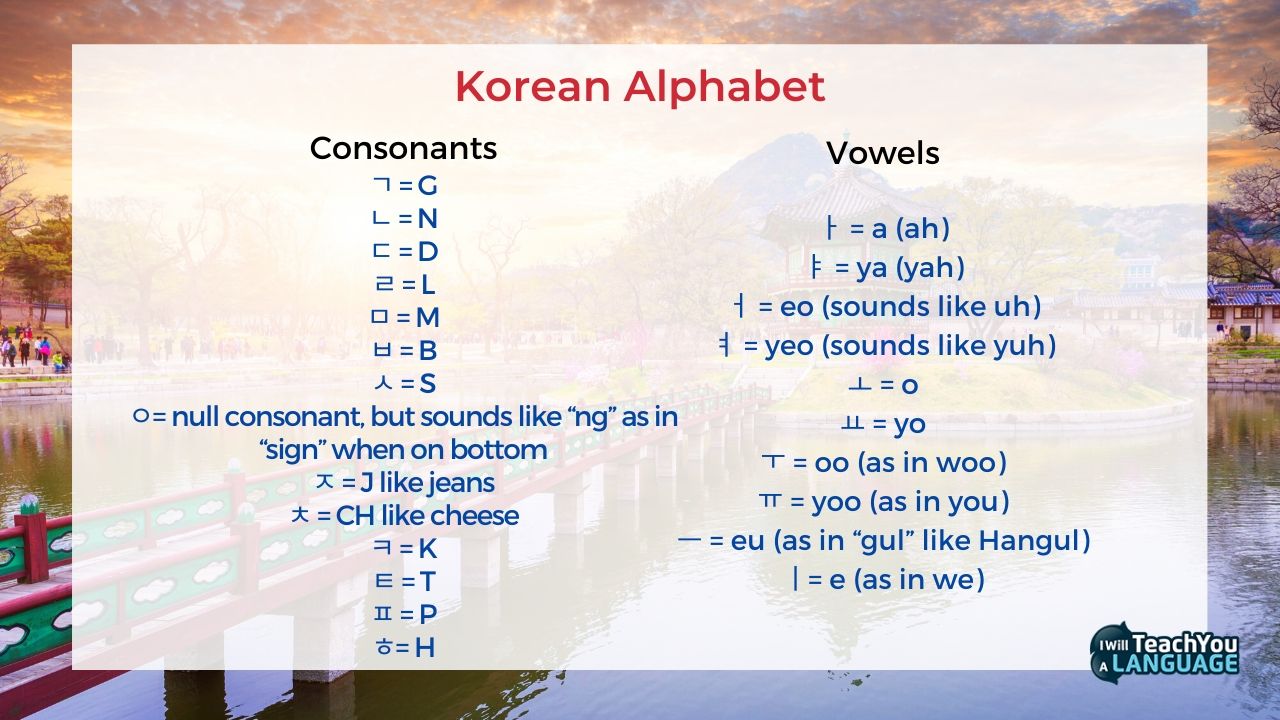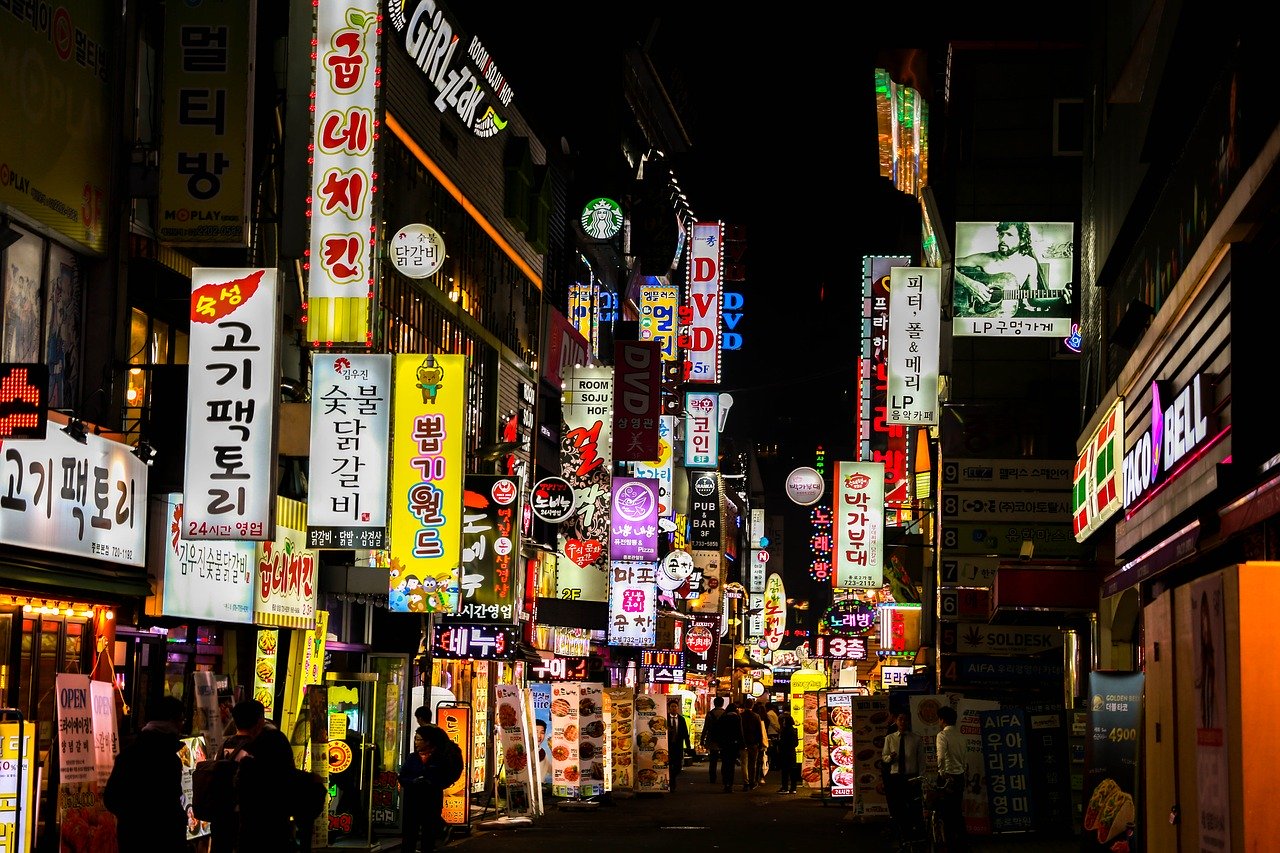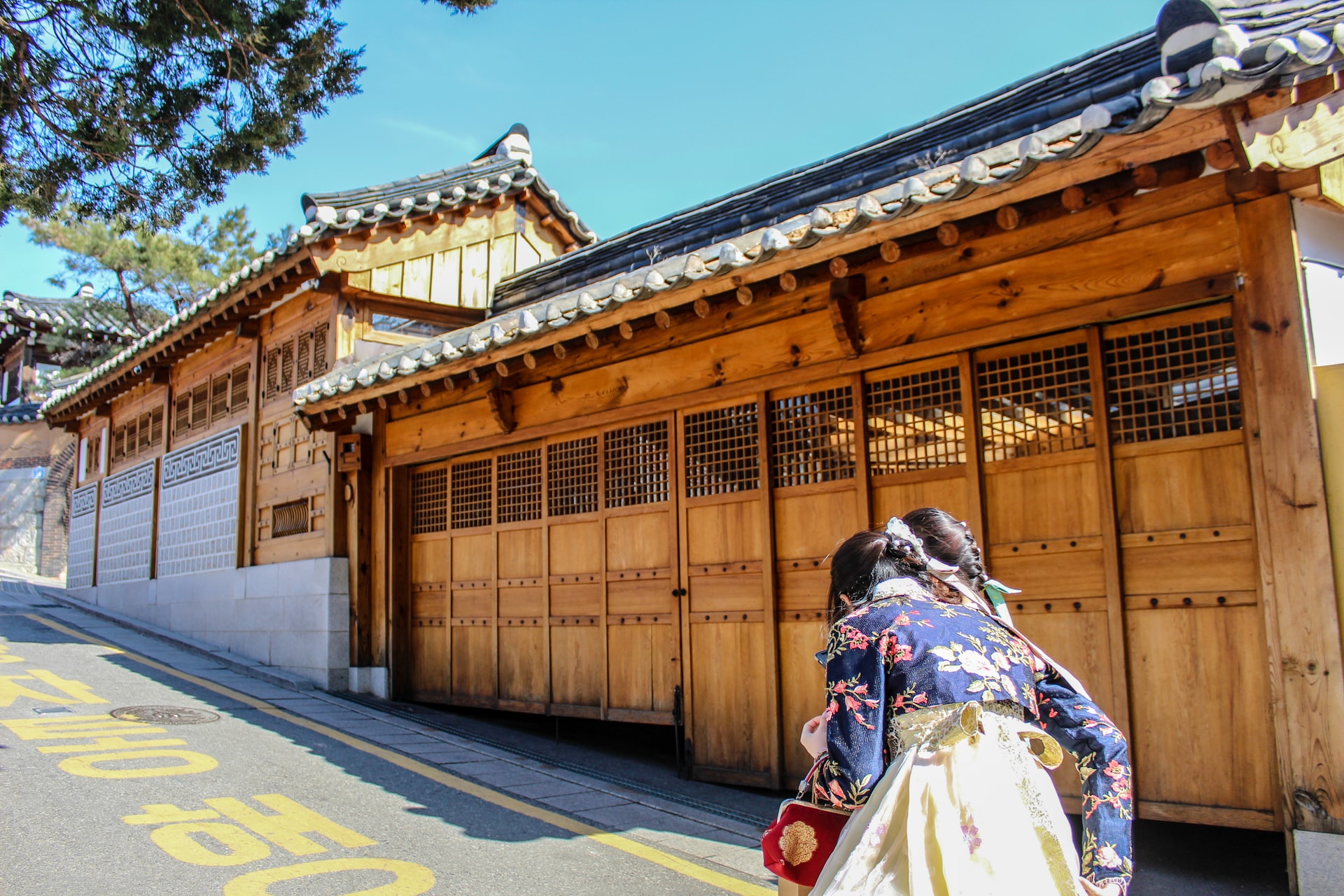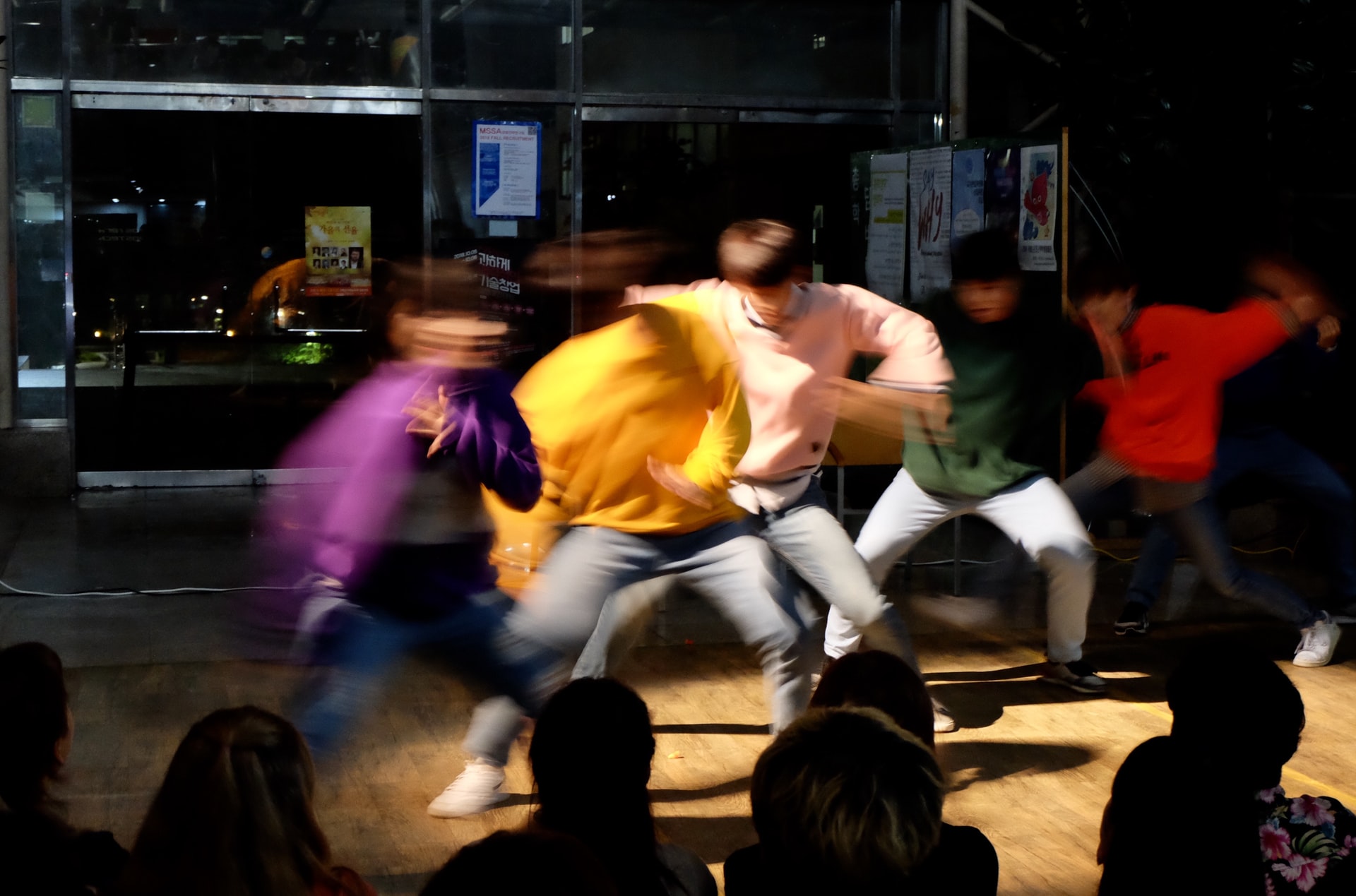
Learning Korean? No wonder!
We all remember when the song “Gangnam Style” exploded onto the world stage. It became the first YouTube video to reach one billion views.
Since then, we’ve all been riding the K-wave (Korean Wave). From kimchi to K-drama and BTS and everything else we now see everyday, you can now find bits of Korean culture everywhere.
What ties all of these fantastic things together? The Korean language. And though Asian languages are generally considered some trickiest for English speakers, Korean has a hidden secret.
Unlike Japanese and Chinese, which have thousands of characters you have to memorize, Korean has a simple alphabet called Hangul (prounced “Hahn” “Gul”).
Hangul consists of just 24 letters—two fewer than the English alphabet. That means, even if you don’t understand what things mean, you can learn to read it easily. Some people even master it in just a few hours!
In this post, you’re going to discover the delightfully simple Korean alphabet. Forget the stress and get ready to read and write the Korean alphabet like a pro in no time.
By the way, if you want to learn Korean fast and have fun while doing it, my top recommendation is Korean Uncovered which teaches you through my fun, unique and effective StoryLearning® method.
If you’re ready to get started, click here for a 7-day FREE trial.
A Little Background On The Korean Alphabet

“A wise man can acquaint himself with them before the morning is over; even a stupid man can learn them in the space of ten days.” -a common saying about Hangul
Before Hangul, the Korean alphabet used Chinese characters. That meant only a small portion of the Korean population could learn to read and write.
But in 1446, King Sejong the Great personally invented Hangul so that everybody could learn these vital skills. And it worked!
Korea became one of the most literate countries in the world. In fact, it’s so effective that it’s now used to preserve other languages that had formerly only been spoken.
“Hangul” literally translates as “Korean Letter” coming from the words “Han” (Korean) and “Gul” (Letter).
Basic Facts About The Korean Alphabet
One of the things you’ll appreciate most about Korean is that the letters all have a distinct sound. None of them have multiple pronunciations like they do in English.
What does that mean? Think about the letter “C” in English. It can sound like “CAT” or “CEREAL” And that’s just the beginning. You can probably think of ten other letters or words that don’t make sense right off the top of your head. What’s up with “G”? G for “Giraffe” and “Golf.” It’s enough to make your head spin!
In Korean, on the other hand, each letter of the alphabet represents a single sound. So, for example, Korean has one letter for S (as in Swim) – “ㅅ” – and anytime you see this letter it will always represent the same sound! Easy, right?!
The same goes with every other Korean letter. Anytime you see it, you can always expect to for it to make the same sound.
To help you become more familiar with the Korean alphabet and how it sounds, we’re going to takes look at the first three letters. In the same way, we say “ABC,” to refer to the English alphabet, Koreans say “ga,” “na,” “da.”
- ㄱ “g” as gold.
- ㄴ “n” as in “nancy.”
- ㄷ “d” as in “dog”
Not so hard, right? You do need to keep in mind the way we translate between the Korean alphabet and English letters isn’t perfect.
Think of it more as a guide than a perfect representation. Be sure to listen carefully as there are subtleties in how you pronounce each letter.
Korean Consonants
You might be wondering why do Koreans say “Ga, Na, Da,” even though the letters just have a “G,” “N,” and “D” sound. That’s because you cannot write a consonant by itself in Korean.
Consonants always need a vowel pair. That’s why the alphabet goes “Ga,” “Na,” “Da” because you add the vowel “ㅏ” (a as in “ah”) to the consonant making it “가나다” or “Ga, Na, Da.”
Let’s practice a few times. What sounds do these make? (Remember: G = ㄱ, N = ㄴ, D = ㄷ and “ah” = ㅏ).
- ㄱ
- ㄴ
- ㄷ
- ㅏ
- 가
- 나
- 다
- 가
- 다
- 나
Here are the answers:
- G as in “gold”
- N as “Nancy”
- D as “dog”
- Ah
- Ga
- Na
- Da
- Ga
- Da
- Na
Before moving on, practice this a few times until you get the hang of it. Pay attention to how the letters look. It can be a little tricky at first, but you’ll master it in no time!
There’s one more thing you should know about Korean right from the start. Unlike Chinese, Thai, and many other Asian languages, Korean is NOT tonal. That means it’s much more forgiving with pronunciation.
It’s yet another way Korean is one of the easiest Asian languages to learn.
How Many Letters Are There?
Korean has 24 letters in total:
14 consonant letters (ㄱ ㄴ ㄷ ㄹ ㅁ ㅂ ㅅ ㅇ ㅈ ㅊ ㅋ ㅌ ㅍ ㅎ)
10 vowel letters (ㅏ ㅑ ㅓ ㅕ ㅗ ㅛ ㅜ ㅠ ㅡ ㅣ)

Keep These Additional Letters On Your Radar
Korean really does have 24 letters. But it has a few bonus ones that come from combining certain letters together into one.
These are double consonants and mixed vowels which you’ll come across as you start reading more words. But they’re not difficult at all. In fact, the more you become familiar with the Korean alphabet, the more you’ll see just how much they all make sense.
Korean Double Consonants
All double consonants make a strong consonants sound. All you do is put extra emphasis on the original consonant. Think of it like “BAnk” instead of “bank.” As your practice, you’ll hear the subtle difference between single and double consonants.
- ㄲ = strong g like “gate” or “go”
- ㄸ = strong d like “dog” or “day”
- ㅃ= strong b like “bank”
- ㅆ= strong s like “snake”
- ㅉ= strong j like j “John”
One famous word with a double consonant you might even know already is “Jjajang myeon” (pronounced JAH-jang myeon). It’s a very popular Korean noodle dish.
Mixed Vowels & Consonants In Korean
Korean also has some mixed vowels and consonants. These form when you put certain sounds together. Say everything very slowly to yourself and you’ll hear how the sounds come together.
- ㅐ sounds like ae as in “day”
- With ㅐ, you combine ㅏ(a) plus ㅣ(e) to make ㅐ(ae).
- ㅒ sounds yae as in “yay”
- With ㅐ, you combine ㅑ(ya) plus ㅣ(e) to make yae.
- ㅔ sounds like ae in “day”
- With ㅔ, you combine ㅓ(eo) plus ㅣ(e) to make ae.
- ㅖsounds like yae as in “yay”
- With ㅖ, you combine ㅕ (yeo) plus ㅣ(e) to make yae.
- ㅚ sounds like “we”
- With ㅚ, you combine ㅗ (o) plus plus ㅣ to make we
- ㅙ sounds like “way”
- With ㅙ, you combine ㅗ (o) plus plus ㅐ(ae) to make way
- ㅟ sounds like “we”
- With ㅟ, you combine ㅜ (oo) plus ㅣ(e) to make we
- ㅞ sounds like “way”
- With ㅞ, you combine ㅜ (oo) plus ㅔ (ae) to make way
- ㅢ sounds like eui “oo we.” This is a unique Korean sound, you’ll get the hang of over time.
- With ㅟ, ou combine ㅡ (eu) plus ㅣ (e) to make oo we
- ㅝ sounds like wuh.
- With ㅝ, you combine ㅜ (oo) plus ㅓ(eo) to make wuh
Don’t worry about memorizing all these letters just yet. We’re going to keep it simple with a few of the letters so you can see how Korean works first. Then I’ll break everything down into digestible bits and walk you through the alphabet step-by-step.
How To Arrange Letters In Korean
You might have noticed the Korean alphabet looks a little like the game Tetris. That’s because it’s always written in one syllable blocks. Each block always follows one of these four rules:
This diagram shows the four different ways you can arrange letters to make one syllable in Korean. “C” equals Consonant and “V” equals vowel.
You can have:
- a consonant on top of a vowel.
- two consonants with a vowel in between them like a sandwich.
- a consonant and a vowel side-by-side.
- a consonant and a vowel together with a consonant underneath both of them.
Remember, you can never have a consonant by itself. It must have a vowel pair.
Practising Syllables In Korean
Let’s practice syllables with a word you probably already know: “kimchi” (a traditional Korean food). We’re going to just do this in English for now.
Kimchi has two syllables, the first is “kim” and the second is “chi.” This means you would write “kim” in one block and “chi” in the second when writing in Korean.
Now we’ll practice a few more common Korean words. Draw a line between the syllables.
- Bulgogi (barbeque beef)
- Kpop (Korean pop music)
- Soju (a type of Korean alcohol)
- Gochujang (Korean chili paste)
Where did you draw the lines? It should look something like this:
Bul * go * gi
K * pop
So * ju
Go * ju * jang
Don’t worry if this seems like a lot to take in at one time. To make it easy, just remember for now that consonants always come first and must have a vowel.
One more thing: Korean vowels are never written by themselves. If you want to make an “a” sound, you have to write it with the placeholder consonant “ㅇ.” To read and write “ah,” you then write “아.”
The easiest way to remember it is that the placeholder looks like the number zero, so it makes no sound.
Putting Together Some Simple Korean Words

Now that you have a sense of what the Korean alphabet looks like and how to arrange letters to make words, let’s see practicing putting some letters together:
Do you remember these four letters?
- ㄱ
- ㄴ
- ㄷ
- ㅏ
What sounds do they make? That’s right it’s:
- ㄱ =g (g as in “gold”)
- ㄴ =n (n as in “nancy”)
- ㄷ = d (d as in “dog”)
- 아 =a (a as in “ah”)
So now we can put these together to make some basic sounds and words.
- 가 = ga
- 나 = na
- 아 = a
- 간 = gan which means “go” in English.
How did we assemble these? Remember our rules from above. In this case it was rule 4: you can put together a consonant and vowel with a consonant underneath them.
So we took 가 which is ㄱ + 아 and added ㄴ underneath it. To make 간 or “gan.”
Let’s do another. But we’re going to add a new consonant first. This one is a b as in “boy” sound.
- ㅂ = b
- 바 = ba
Now try this word that shows you how easy it is to read the Korean language.
- 바= ba
- 나 = na
- 바나나 = ba na na or “banana”
This one is really simple. Each syllable follows rule 3: you can have a consonant and vowel next to each other.
Banana is just one of many ‘Konglish’ (Korea + English) words you’ll often hear in Korean.
More Practice
Let’s try another one to make one of the most popular Korean words.
- 바= ba
- ㅂ= b
- 밥= bab which means rice in Korean.
Notice how it follows the stacking rules from above. Can you identify which rule it is? Notice you have a consonant then a vowel then a consonant underneath. That right is Rule 4.
* Rice is so important in Korean culture that another way to say “hello” is “have you eaten rice today?”
Here’s an easy one. This time try to put it together by yourself.
가
다
Did you get it? It’s 가다 (ga da), which means “to go.” Which rule is this? You have a consonant and vowel. So it has to be Rule 1.
Another helpful thing you’ll learn about Korean is that all verbs end in “다” in their basic form, so it’s really easy to recognize them.
Practice reading these words and identify which rule they follow. Over time, you’ll be able to do this unconsciously.
Another Korean Vowel
Before we get started, we have to introduce you to one more vowel so you can see all the different ways to arrange syllables. It’s time you meet “ㅗ” which makes an “O” sound.
- ㅗ = o as in “oh”
Don’t forget we can never leave vowels by themself. So you’ll see it written like this:
- 오 = oh
While we’re practicing, do you remember this one “아.” That’s right it’s “ah”
Now you’re ready. Read the syllables and identify which rule it follows:
- 고
- 간
- 바나나
- 봅
- 가다
- 보보
- 각
Here’s what they should sound like:
- Goh (Rule 1)
- Kahn (Rule 4)
- Ba Na Na (Rule 3)
- Bohb (Rule 2)
- Ka da (Rule 3)
- Bo bo (Rule 1)
- Gahg (Rule 4)
Now, take the letters you learned so far and practice writing them on your own:
- ㄱ =g
- ㄴ =n
- ㄷ = d
- ㅂ= b
- 아 = a
- 오 = o
Don’t worry; the words don’t have to mean anything. Just get the hang of how to arrange them in the right order.
When Should You Learn The Korean Alphabet?

As soon as possible! As I always say: learn the script from the start. The sooner you learn the alphabet, the sooner you’ll be able to start writing and reading sentences on your own.
But that’s not the only reason. You’ve probably seen “romanizations” of Korean or Korean written in English letters. Although it might seem easier to read Korean like this, it’s actually much harder.
Remember why Korean is so great—because all letters and vowels sound like they should, with no confusing letter like “c,” “g,” and all the other tricky ways we write in English.
For that reason, there is no perfect direct translation between sounds in Korean and English letters. What you get are words that don’t make much sense.
Let’s go back to the hit song “Gangnam” Style. If you read this in English, you might think it sounds like “Gang” as in the English word “Gang”, when really it’s more like “Gahng” to make it “Gangnam” Style.
And this is not the only world like this. Almost every Korean word sounds different when written in Korean. And if you want other people to understand you in Korean as well as to understand what Korean sounds like, you’ll need to know how the letters really sound.
When written in Korean, Gangnam is much simpler to pronounce correctly. :
- 강 kahng = river
- 남 : nahm = south
- 강남= South river (a district in Seoul).
Gangnam refers to the trendy area south of the Han River, which divides Seoul in half. This district and its flashy and often silly ways are what Psy is singing about in Gangnam Style.
Do yourself a favor and start learning the alphabet asap. You can then begin to read things in Korean— even if you don’t know what all the words mean just yet.
5 Tips To Learn The Korean Alphabet Like a Pro

We’re not going to lie. Even with such an amazingly easy script, Korean is still a tricky language to learn. But compared to other Asian languages like Japanese, Chinese, or Thai, this gives you such a helpful boost when you are getting started.
1. Practice The Script As Much As Possible Right Away
You might not remember it all in one morning as the famous quote says, but the more often you practice it, the easier it will get.
Make flashcards with all the letters and then start putting basic words together even if they don’t mean anything.
2. Texting Will Get You There
Did you know Korea has its own extremely popular messaging app called Kakao Talk? Nowadays, you can easily get a Korean keyboard on your smartphone.
If you’re a little confused about all the stacking and arranging, you don’t have to worry. Your smartphone will put things in the right order for you. Pay attention, and you’ll get the hang of it in no time!
3. Hangul Wasn’t Built In A Day
Hangul took King Sejong and his team years to create. It then took many more years for it to catch on with the masses. Don’t strain yourself trying to remember all 24 letters on the first day.
Break it up into manageable pieces. After a few weeks, you’ll be impressed by just how far you’ve come.
4. Menus, Menus, Menus
Looking at menus is a great way to practice, especially if you already know the names of your favorite Korean dishes. And, since many menus include pictures, it will help you to remember some useful vocabulary.
5. There Is Konglish Everywhere In Korean
We talked about “바나나” or “banana” early. Keep an eye out for more Konglish because you can see everywhere. Common Konglish words include “피자” or “Pizza” (pronounced “Pee Jah”) or “콜라” which is “Kola” as in Coca-cola and other sodas.
How To Learn The Korean Alphabet: The Bottom Line

Learning a foreign language may seem daunting—especially one as different from English as Korean. As you’ve worked through this lesson, however, you’ve seen it really isn’t that difficult after all!
Thanks to Hangul, it’s actually really easy to read and write the Korean language. You’ve already practiced 4 consonants and 2 vowels out of 24 letters in total or about 25% of the written language in total!
Did you realize when you started that you’d get this far so quickly?
Keep breaking it down into these manageable chunks and you’ll have it mastered in no time.
This won’t only help your comprehension but your pronunciation too. From here, you can start building sentences and practicing conversation skills.
Whether you want to sing like your favorite idols, act like you're in a K-drama, or dive into the amazing history and culture of Korea, there’s no better way to begin than by learning the Korean alphabet, Hangul.
So stick with it and you’ll achieve your Korean language goals in no time!

Olly Richards
Creator of the StoryLearning® Method
Olly Richards is a renowned polyglot and language learning expert with over 15 years of experience teaching millions through his innovative StoryLearning® method. He is the creator of StoryLearning, one of the world's largest language learning blogs with 500,000+ monthly readers.
Olly has authored 30+ language learning books and courses, including the bestselling "Short Stories" series published by Teach Yourself.
When not developing new teaching methods, Richards practices what he preaches—he speaks 8 languages fluently and continues learning new ones through his own methodology.











































